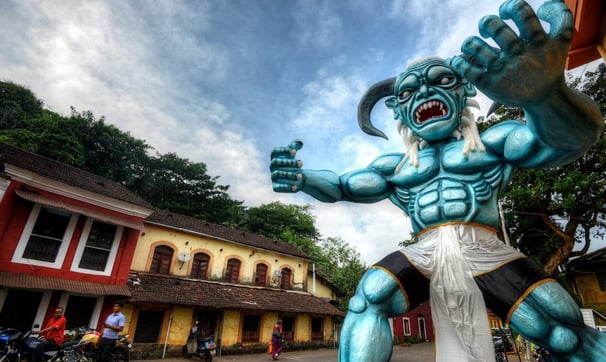Narkasur Tradition in Goa
CULTURE


The Fiery Effigies of Narkasur: A Goan Deepavali Tradition
Deepavali in Goa is more than just twinkling lights and sweet treats; it's a spectacle of vibrant traditions, and one of the most unique is the creation and burning of Narkasur effigies. This larger-than-life ritual, steeped in mythology and local creativity, transforms the festival into a thrilling display of artistry and community spirit.
The Mythical Roots:
Narkasur, according to Hindu mythology, was a demon king who terrorized the people. Lord Krishna, along with his wife Satyabhama, vanquished this evil force, liberating the land. The burning of Narkasur effigies during Deepavali symbolizes this victory of good over evil, a theme that resonates deeply with the festival's core message.
Goa's Grandiose Displays:
In Goa, the celebration takes on a unique and elaborate form. Communities, especially youth groups, dedicate weeks to crafting massive Narkasur effigies. These aren't mere stick figures; they are often towering structures, meticulously constructed from paper, bamboo, and other materials.
The effigies showcase incredible artistry and ingenuity. They can range from traditional depictions of the demon to contemporary interpretations, often incorporating social or political themes. The level of detail and creativity is truly remarkable, making each Narkasur a work of art.
The Night of the Burn:
On the eve of Deepavali, the streets of Goa come alive with processions. The Narkasur effigies, illuminated by lights and often accompanied by music, are paraded through the streets, drawing crowds of excited onlookers. The atmosphere is electric, filled with anticipation and festive cheer.
As the night progresses, the effigies are brought to designated areas, where they are set ablaze. The burning of Narkasur is a dramatic spectacle, with flames leaping into the night sky, symbolizing the triumph of good over evil. The crackling sounds and the intense heat create a powerful and unforgettable experience.
A Community Celebration:
The creation and burning of Narkasur are not just individual efforts; they are community events. Youth groups work together, pooling their skills and resources to create the most impressive effigies. The processions and the burning are also communal celebrations, bringing people together to share in the festive spirit.
Beyond the Spectacle:
While the visual spectacle of Narkasur is undoubtedly captivating, the tradition also holds deeper meaning. It serves as a reminder of the importance of overcoming negativity and embracing the light of goodness. It's a celebration of courage, resilience, and the enduring power of good over evil.
Experiencing Narkasur in Goa:
If you're fortunate enough to be in Goa during Deepavali, don't miss the opportunity to witness the Narkasur celebrations. It's a unique and unforgettable cultural experience that showcases the vibrant traditions and artistic spirit of the Goan people.
Tips for Visitors:
Respect the Traditions: Remember that Narkasur is a cultural and religious event, so be respectful of the traditions and rituals.
Be Mindful of Crowds: The processions and burning events can attract large crowds, so be prepared for crowds and take precautions to ensure your safety.
Capture the Memories: Bring a camera or phone to capture the spectacular displays.
Enjoy the Festive Atmosphere: Immerse yourself in the festive spirit and enjoy the unique cultural experience.
The Narkasur tradition in Goa is a powerful and visually stunning way to celebrate Deepavali. It's a reminder of the enduring power of good over evil and a testament to the vibrant cultural heritage of the region.
